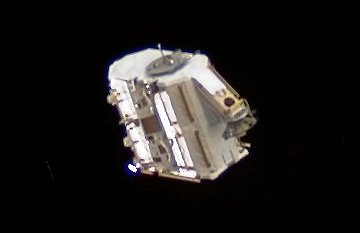| DWARF PLANET NAMED: The solar system now has four dwarf planets. The newest member of the club is Makemake (pronounced "MAH-keh MAH-keh"), named by its discoverer Mike Brown after a Polynesian fertility god. (Brown's wife was pregnant when the object was discovered.) The International Astronomical Union (IAU) approved the name on July 19th. Makemake is about two-thirds the size of Pluto and it lies 1.65 times farther from the sun: IAU press release. BIG SPACE JUNK: Weight: 1400-lb. Size: Like a double-wide refrigerator. It is, in short, one big piece of space junk: 
Above: The EAS photographed on July 23, 2007, by ISS astronauts: more.
The Early Ammonia Servicer (EAS), pictured above, was thrown overboard from the International Space Station on July 23, 2007, almost one year ago. At the time, the castaway was in a high orbit and barely visible from Earth's surface. Not anymore: Twelve months later, with its orbit decaying, the EAS has become easy to see. "The EAS has noticeably brightened," reports veteran satellite observer Marco Langbroek of Leiden, the Netherlands. "A year ago it was a difficult naked eye object at mag. +4 to +4.5, but on July 20, 2008, I easily observed it at mag. +2.5 to +2.0, moving very fast due to its low orbit: photo." The EAS is expected to reenter Earth's atmosphere and disintegrate near the end of 2008 or early 2009. Until then, you can see it, growing brighter as it descends, with your own eyes. Europeans are favored with flybys this week, North Americans next week. Check our Simple Satellite Tracker to find out when to look. VIDEO BONUS: On July 15, 2008, Kevin Fetter used a low-light video camera to photograph the EAS orbiting over his home in Brockville, Ontario: movie. "The bright star in the video is Altair," he says. "It was nice to see the EAS still hanging on." | 
